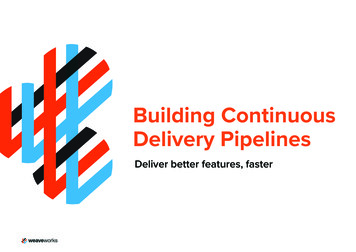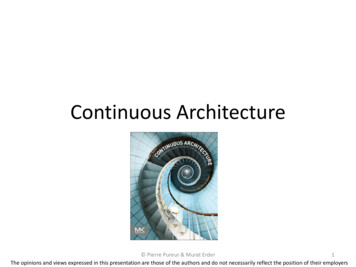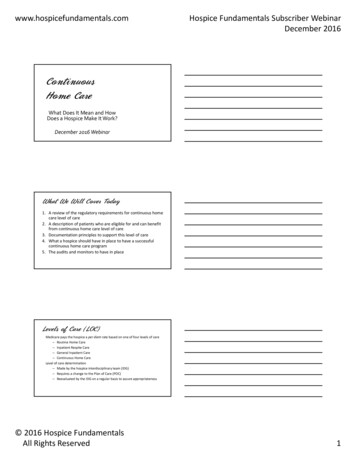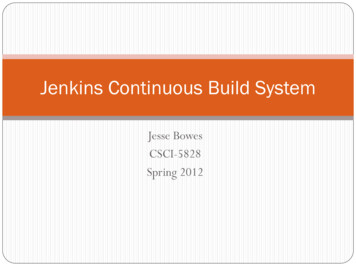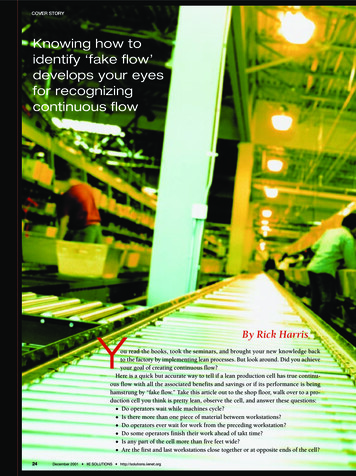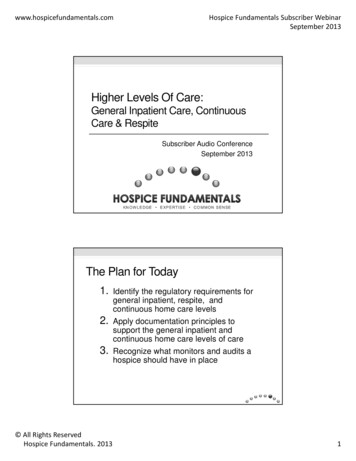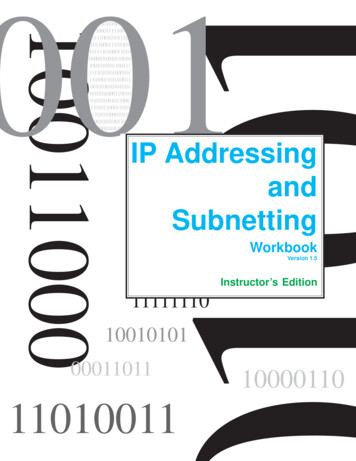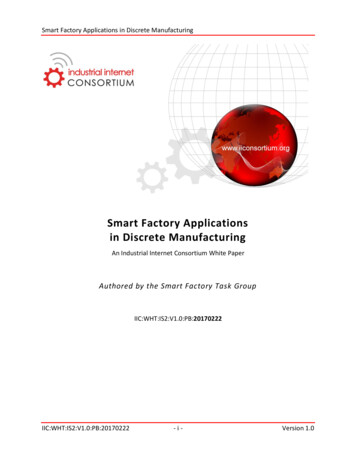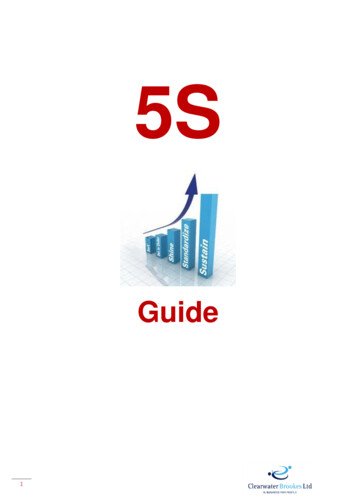
Transcription
5SGuide1
What is 5S?5S is a technique that results in a well-organized workplace complete with visual controlsand order. It’s an environment that has “a place for everything and everything in its place,when you need it”.5S produces a workplace that’s clean, uncluttered, safe and organized. People becomeempowered, engaged and spirited by linking people and processes, product begins to flow atthe drumbeat of the Customer. The 5S’s are;1.2.3.4.5.SortSet in orderShineStandardizeSustain“Visual order is the foundation of excellence in manufacturing. When it is in its place on theproduction floor or office, work gets done efficiently and effectively. When it is not in place,work still gets done – but at a level of cost to staff and the company that is hard to justify”.5S is not just a clean-up campaign; it’s a system that allows individuals to work moreefficiently. It requires; Perseverance and determination The ability to see what’s important Attention to detail5S is the key first step in workplace & work culture improvement.“Sort” Remove from the workplace all items that are not needed for current work oroperation. Sorting means leaving only the bare necessities. When in doubt, remove it.“Set in Order” Arranging needed items so that they are readily accessible and labelled sothat anyone can find them or put them away.“Shine” Sweep and clean the work area. The key purpose is to keep everything in topcondition so that when someone needs to use something, it is ready to be used. Cleaning awork area produces an opportunity to visually inspect equipment, tooling, materials and workconditions.“Standardize” Define what the “normal” condition of the work area. Define how to correct“abnormal” conditions. The standard should be easily understood and easy to communicate(i.e. visual controls).“Sustain” Implementing solutions to address the root causes of work area organisationalissues. All employees must be properly trained and use visual management techniques.2
Application and Intent of 5S’s#1 SORT: CLEARING THE WORK AREADefine what is required & what is not requiredDisposition All ItemsTake Team ActionWhat to Do With Items No Longer Needed#2 SET IN ORDER: DESIGNATED ORDERLY LOCATIONSMaximize Storage Proximity & Storage OptionsLocation-Specific Designated StorageDesignated Space and Location, Placement, and Potential PaperworkStorage Don’ts, Signs, Labels, and Colour Coding for Storage Locations#3 SHINE: CLEANLINESS AND WORKPLACE APPEARANCETips for Cleaning the WorkplaceCleaning Tools, Schedules, and Personnel ResponsibilitiesMaintaining Workplace AppearanceShine Measures of Prevention#4 STANDARDIZE: EVERYONE DOING THINGS THE SAME WAYStandardize the Same WayTips for Formal MethodologyRoles and Responsibilities and Continuous Improvement#5 SUSTAIN: MAKE IT PART OF THE CULTURELeadership and CommunicationPrevent Backsliding to Old HabitsRoles and Responsibilities for Continuous ImprovementIMPLEMENTING AN ORGANIZATION WIDE 5S SYSTEMRoadmap and Plan for 5S ImplementationLeadership Team Roles and Building the InfrastructureCommunication and Team 5S TrainingConducting successful 5S Pilots3
5S is a way of identifying not just the Waste in your process butalso the sources of waste and removing those from every day waysof working4
How to conduct 5SSORTClearing the area means organizing the workplace so that it is a more effective,more efficient place to work. It involves sorting out what is not needed to perform the required work in the workarea.If it's not needed, remove it.Use the 48-Hour Rule Instead of keeping things around that might get used someday, apply the 48-hourrule to everything in the work area.The 48-hour rule says: If it is not going to be used in the work area within 48 hours, itdoes not belong there.The steps used to identify what is and is not needed in a work area and then toclear the work area of the unnecessary items are: Define what is needed.Define what is NOT needed.Disposition the items.Take action: Sort out (move out) what is not needed and move in what is needed(and is not there now).Define what is needed When considering what is needed in a work area, don't just look at the coreequipment and tools used. Consider the materials, supplies, and even thepaperwork.This is also a good time to evaluate the proper quantities of items to keep in the workarea.Defining what is needed in a work area is not something that can be done effectivelyby one person working alone; use a team representing all that work in the area.Define what is NOT needed After the team has identified what needs to be in the area, focus on all the otheritems currently in the work area.If an item is not needed to make the product, support the operation of the equipment,or for safety reasons, then it probably should not be kept in the direct work area.Disposition the items 5Once items that are not needed in the work area are identified, it's time to dispositionthem and determine where they should be stored.Tag items to be removed; use a standardized set of usage-based guidelines todisposition items to be removed.
Whenever possible, use data to determine the frequency of use, do not guess. Theless frequently an item is used, the farther from the work area it should be stored.Take action Once items are dispositioned, it's time to take action to clear the work area and movetagged items to a temporary holding area.The holding area should be an accessible place where others not on the team canexamine the items, confirm that they do not need to be kept in the work area, ordiscuss why they think an item is needed in the work area.Recap The goal of the first of the 5S's, Sort, is to have only what is needed for the job in thework area.The Sort phase applies to all work areas, manufacturing departments, serviceprocesses, and offices.Dispositioning ItemsIdeas for using 5S Tags and Dispositioning items during the Sortphase:No 5S Tag Used at least once every two days.Do not remove the item from its place of use.5S Tag, Type A Used about once a week.Remove it from the direct work area but store it close to the work area.5S Tag, Type B Used once a month.Store it somewhere accessible in the facility.5S Tag, Type C Used once a year or less frequently.Consider storing it outside or moving it off-site.5S Tag, Type D 6No longer needed.Remove: sell, return, donate, or discard.
Sorting: What to do with Items No Longer NeededSuggestions for disposing of items deemed to be no longer needed during the Sort phase:Sell it If equipment or tools are no longer needed, your company may be able to sell themon the used equipment market.Return it for credit If raw materials or supplies are no longer needed but they are within their useableshelf life, your company may be able to return them for credit minus a restockingcharge.Give it away If your company cannot sell the equipment, tools, or supplies, consider donatingthem to a school or not-for-profit organization for tax credit.As a last resort, throw it away If it is a raw material, be sure to check with your safety and environmental staff todetermine the proper and safe way to dispose of it.5S Sort ChecklistWhat: Examples of items to sort out “Too much” stock, supplies, & materialsSupplies and tools no longer neededObsolete materials or partsObsolete or damaged tooling & fixturesAnything that will not be used in the next 48-hoursWhere: Examples of places to check 7Along walls, partitions, & columnsIn cornersOn mezzaninesOn top of all flat surfacesUnder desks & workbenchesDesk & workbench drawersInside cabinetsAny stack or pileBulletin boards, schedule boardsTool boxes
SET IN ORDERSet in Order or designating locations is about organization and orderliness. Itmeans that there is a place for everything and everything must be in its place. Once the Sort phase has been conducted (deciding what should be in the work areaand what should be removed from the direct work area), it's time to designate aspecific location for everything.Using designated locations requires discipline and attention to detail from everyonein the work area.Designated locations save time and reduce both wasted effort and frustration. Having designated locations for everything needed in the work area enablesemployees to exert visual control over their operations. At a glance, employees areable to see if things are in-place or out-of-place and if more materials, supplies, ortools need to be ordered.Effectively establishing designated locations requires knowledge of storagedevices and options. On the surface, designating a location may seem like a simple and straightforwardtask, and sometimes it is. However, establishing effective "homes" for some itemsrequires insight into their use and knowledge of storage and identification options.A study of the location, type of storage, and labeling conventions is needed todevelop storage systems that help make the work area more effective andproductive.Effective storage is based on a combination of factors such as the frequencyof use, the sequence of use, and the bulk or cubic feet occupied by the itemstored.There are numerous forms and types of storage arrangements. It's best to befamiliar with the options so that you can select the best mode of storage for aparticular item. Modes of storage include: The FloorRacks and ShelvingFlow RacksCabinetsCartsStorage BinsPortable EquipmentCustom StorageCentral CribsShadow BoardsHanging ToolsThe use of signs and labels to identify "what is to be stored where" helpsemployees use storage locations as they were intended to be used 8The information contained on the labels will be easier for all employees tounderstand if the format for the labels is standardized.Where storage locations might change slightly, consider portable labels. For
example, magnetic labels work extremely well on racking in storage and warehouseareas.For consumables, another alternative is to use kanban cards mounted in plasticsleeves as the labels. When the reorder quantity is reached, the kanban card can beremoved from the sleeve and be used to reorder that item.Storage ProximityConsiderations for determining storage locations during the Set in Order phase:If the item is used several times a day: Store “on the equipment” if possible.If the item is used at least once every two days: Store in the work area.If the item is used about once a week: Store close to the work area.If the item is used once a month: Store somewhere accessible in the facility.Storage OptionsOptions to consider when selecting or designing storage devices during the Set in Orderphase:The Floor For some large or heavy materials, tools, or equipment, the only logical thing to do isstore them on the floor.Designate a dedicated space for the item, mark the space on the floor, and use itonly for that item.Racks and Shelving Racks and shelving allow the effective use of cubic feet rather than just square feetused for storage by making vertical space available.Labelling shelves and first-in, first-out practices are important to ensure that theshelves are effective 5S aids.Flow Racks 9Gravity flow racks are excellent to ensure FIFO (first-in, first-out) inventory practicesare followed.Flow racks can be designed for either cartons or pallets.
Cabinets Cabinets can be both good and bad for organizing a work area. They are good forstorage. They are bad in that they can be used to "hide things."It takes discipline to ensure a cabinet is a valuable 5S tool and does not detract fromthe effort.Carts Carts are ideal for moving things into the work areas when needed and then out ofthe way when not needed.Storage Bins Storage bins are available in all sizes, from small desktop containers to large, rollablebins.Using different colour bins to designate different tasks or product families provides avisual check to help make sure a bin is not out of place.Portable Equipment Any equipment that can be made portable should be. This will allow it to be rolled intothe work area when it is needed and then rolled back to its home when the job isdone.Do not forget to designate the area for storing the portable equipment when it is notin use.Custom Storage Even unusual shaped and sized items can be organized.After reviewing the item, a maintenance professional can often design and build acustom storage system for those items.Central Cribs or Storeroom Using a centralized storeroom as the designated storage location is rarely aseffective as it may seem at first.Instead of a central crib, why not consider keeping equipment and supplies insatellite storerooms in the area where they are needed?Shadow Boards Shadow boards provide a visual place to store hand tools and gages. It is easy tosee at a glance what is missing from the board as well as what should be placedwhere on the board.Hanging Tools 10One method to organize tools in work areas is to mount them from retractable reelsabove the work area. This keeps them out of the way when not needed, but keepsthem right at hand for when they are needed.
Location-Specific Designated StorageTips for designing and defining designated storage spaces:Designated Space on the Floor When items are stored on the floor in the work area, make sure the allocated storagespace is not in the way; keep the designated spaces out of the workers’ travel paths,material-handling aisles, and away from electrical equipment.Designate the space by outlining the space with colour tape or paint and labelling thespace.Kanban Locations A kanban is a signal to trigger replenishment of inventory. The kanban can signal it istime to pull inventory from storage or to start the next production run.Kanban space options include full boxes, peg boards with a specific number ofopenings or slots, and totes with predetermined quantities.Kanban spaces for raw materials, work-in-process, or finished goods should beclearly marked.Consider adding signs above the kanban areas that note the item or items andmaximum quantities that should be stored in the space.Safe Placement When designating locations, take into account the weight and size of the object.There should be easy access to the storage location, especially to items that arefrequently used. Make sure there is enough room around the object to access itsafely.To avoid potential injuries, heavy items (approximately 25 pounds or more) that areaccessed manually should not be stored too high or too low.Safe placement also involves the safety of the equipment itself. For example, asensitive electronic instrument should not be stored alongside a fork truck aisleunless protected by a bollard. And flammable materials should be stored in a safetycabinet or flammable storage area, not out in the open.Aisles and Access-ways Painting aisles and access-ways or doorways is useful to show where not to storethings.If the aisles are going to be used for egress, make sure they are wide enough andmeet local and federal regulations.Locations for Waste Containers 11Space in the work area should be allocated for peripherals such as trash cans, wastecarts, cutting fluid or coolant drums, and even cardboard scrap.Designated locations for waste containers must be convenient to the work area ifthey are to be used the way they are intended, but they must not in the way of thework.
A Place for Paperwork Designated locations for process-related paperwork, both for permanent paperworksuch as work instructions and for “transient” paperwork such as travelers or routersare also needed.Permanent paperwork should be stored near where it is used.It's a good idea to store transient paperwork in a plastic sleeve right on the parts orequipment if possible.Paperwork such as data collection forms and SPC control charts should also havedesignated locations. One technique is to use stands for this type of paperwork ateach work area.Storage Don’tsThings NOT to do when arranging and designing storage locations and devices:Don’t Use Worktables as Storage Tables A worktable is not a good storage area.Tables in many work areas seem to become magnets for clutter. Consider removingtables in the work area unless they are needed to perform work.If a table is needed, it should be sized for the work being done on it. Do not allowspace that could be used for storage. Sometimes it's best to replace a table with astand.Don’t Allocate Too Much Space Be careful not to allocate too much space when designating locations.Remember that open areas in any operation tend to get filled up; most of the time theopen area gets filled with things that aren't needed in the work area.Err on the side of using less space rather than more space unless safetyconsiderations are involved.Don’t Waste the Worker’s Time When organizing work areas, be careful not to set the storage up in a manner thatwould waste the worker’s time trying to get at the items.For example, if the worker would have to wait for a fork truck to unstack items, thendon’t stack them to begin with. And don’t put items on the top shelf in an office if theoffice workers will need to take time to locate a step stool or step ladder to getaccess to them.Signs & Labels for Storage LocationsTips for using signs and labels to identify what is stored in specific storage locations:Label the Locations 12When setting in order, label the designated locations and storage containers.The information contained on the labels will be easier for all employees tounderstand when the format for the labels is standardized.When storage locations might change, consider portable labels. For example,magnetic labels work well on racking in storage and warehouse areas.
For consumables, another alternative is to use kanban cards as the labels by havingthem mounted in plastic sleeves at the location. When the reorder quantity isreached, the kanban card can be removed from the sleeve and then be used toreorder the item.Communicate Information with Labels Labels can help communicate information at a glance.For example, color-coding the labels so that the storage locations and types orclasses of inventoried items can be quickly matched saves time.Use Visual Labels Labels containing words or code numbers are good but sometimes pictures are evenbetter.Consider putting a picture or schematic of the item on the label to create a visuallabel that clearly communicates the item stored.Colour Coding Color-coding tools makes it easier to know where they belong and when they are outof place.Consider color-coding peripheral equipment such as chutes, dies, and fixtures thatgo with specific pieces of equipment as well.Set in Order ChecklistSet in Order: Rationale & Techniques The more frequent the use, the closer to the point of use the item should be stored.Arrange equipment, tools, & supplies in the sequence of operations.Base storage amount on cubic feet, not quantity.Use color-coding.Designate locations for specific items.Use labels & signs to identify stored items.Set in Order: Storage Options 13The FloorRacks and ShelvingFlow RacksCabinetsCartsStorage BinsPortable EquipmentCustom StorageCentral CribsShadow BoardsHanging Tools
SHINEThe Shine phase is more than making the work area spic and span. There are three aspects of shine: getting the workplace clean, maintaining itsappearance, and using preventive measures to keep it clean.Cleaning the workplace: Take the time to plan what needs to be cleaned, what it will be cleaned with, when itwill be cleaned, and who will do the cleaning.Maintaining the appearance of the workplace: Techniques and practices that contribute to the appearance of a work area include:painting, lighting, dealing with clutter, dust collection, minimizing spills, andconducting routine maintenance.Using preventive measures to keep the workplace clean: Once the work area, tools, and equipment are clean, they need to be kept that way.Continued housekeeping is one way to keep the work area, tools, and equipmentclean. But the better way is to prevent these from getting dirty in the first place.Root cause analysis, mistake-proofing, and the use of preventive measures areimportant to keep the workplace clean and orderly.Recap: Equipment that is kept clean performs more efficiently and has less unscheduleddowntime. Additionally, many organizations find that productivity and safetyperformance improve as housekeeping improves.Tips for Cleaning the WorkplaceTips for cleaning the workplace in the Shine phase:What needs to be cleaned? 14Actually, everything will need to be cleaned, but the 5S team should take the time tospecifically list out what will be cleaned.Use your list to determine what cleaning equipment and supplies will be needed andwho will do the cleaning.Cleaning the work area does not just mean the process equipment and area directlyaround it. It means the whole area including the floors, the walls, and even theceilings and the lighting fixtures.Even areas under and on top of equipment, areas which are not normally seen,should be cleaned. These areas are often overlooked or ignored.
Cleaning Tools The proper tools are needed for housekeeping just like the proper tools are neededto do the “real” job.Housekeeping equipment and supplies should be kept in designated locations nearwhere they will be used.Set up a kanban system for cleaning supplies.Cleaning Schedules Continual cleaning of a work area is the best approach.If an area “gets dirty” faster than it can be kept clean, find the reason (root cause)and correct it.Set scheduled cleaning times and responsibilities for common areas.Cleaning Responsibilities A formal schedule is best for establishing who will do what and when they will do it. Aposted checklist is a good tool for creating the schedule; use the checklist to indicateresponsibility and record the completion of housekeeping assignments.Maintaining Workplace AppearanceTips for maintaining the appearance of the workplace in the Shine phase:Painting the Workplace Painting is a key part of Shine. Of course, before the area can be painted, it must beclean. Consider painting the walls, ceiling, equipment, and if appropriate, even thefloors.Establish a painting scheme. Different work areas don't need to have the identicalcolours, but they should have the same colour scheme.Proper Lighting It's hard to “shine” when the work area is dimly lit. Even a clean area can look dingyunder poor lighting.Ensure that the work area is bright enough. Natural light is best; consider addingmore windows to the work area. If it's not practical or cost-effective to add naturallighting, add more lighting fixtures or consider replacing bulbs and reflectors.Dealing with Clutter Most of the clutter should have been cleared out and organized in the first twophases of the 5S's, Sort and Set in Order.Things that are often overlooked include postings on the walls or bulletin boards andhoses or wires running along the floor.Effective Dust Collection 15When using powders or friable materials, dust collection systems are a must.Proper dust collection devices prevent work areas from getting dusty and dirty.
Minimizing Spills Equipment that uses cutting fluid, coolant, and hydraulic fluid “always” seems to haveleaks or spills.There are methods for preventing spills; one low-tech approach is to put a pan underan entire piece of machinery to collect and contain spills and drips.One of the keys to minimize spills is to repair leaks immediately after they start.Routine Maintenance Preventing housekeeping problems involves performing maintenance as necessary.If equipment starts leaking, stop the leak. If dust starts blowing around, find thesource and fix it.Don't just use tape or other temporary fixes; follow the temporary measures withpermanent fixes to the problem to prevent recurrence.Carpeting In manufacturing facilities and at building entryways, keeping carpeting lookingacceptable is a difficult job. While regular cleaning and chemical guarding of thecarpet will make the areas look better, consider installing darker, mottled carpeting inhallways and areas accessed from the plant or from the outdoors.One technique to determine what colour carpeting would hide dirt the best is to placesmall pads of white carpeting at the entrances to the office areas from the plant.Then, after a few weeks of traffic, take the now-dirty pads to a commercial carpetfacility and have them match the colour.Preventive (Shine) MeasuresTips to help keep the workplace “Shining:”Root Cause Analysis Treat cleaning and organizing the work area as a process improvement problem. Thesame root cause and problem-solving tools used for quality and productivityproblems can be applied to improving workplace organization and appearance.A key to preventing recurrence of housekeeping issues lies in root cause analysis ofthe problem. Root cause analysis involves collecting and analysing data to find outwhat is at the root of the “dirty equipment or work area” symptoms.Mistake-Proofing Solutions Once the root cause of recurring housekeeping issues is found, identify a solutionthat mistake-proofs the problem and prevents the work area and equipment fromgetting dirty in the first place.Prevention in the Design Stage 16New installations should be designed with housekeeping in mind.Prevention ideas that focus on seemingly unimportant housekeeping issues can leadto significant improvements in appearance over the long term.
STANDARDISEStandardize, the fourth of the 5S's, involves putting the systems inplace to ensure that everyone does things the same way. The methodology for Sorting needs to be standardized, the approach to Set in Orderneeds to be standardized, and Shine especially needs to be standardized.In order to standardize: Roles and responsibilities must be clear and consistently applied.Training will be necessary to ensure all know how to apply 5S techniques and "copyexactly," or apply them the same way.And, as with any improvement initiative, the effort must not be allowed to becomestatic but must continuously evolve and grow.Roles and responsibilities: Roles in a 5S effort are straightforward. Leaders must set the tone and lead byexample.Managers and supervisors must commit to the initiative, provide time for theworkforce to develop and implement 5S changes, provide guidance with thosechanges, and support the 5S changes.Members of the workforce must embrace 5S principles and practices and helpimplement the 5S's in their work areas.5S training: Universal indoctrination in general 5S techniques is needed to help build a common5S vocabulary and skill base.As the 5S's are adopted work-area by work-area, each area will develop uniqueapproaches and methods; anyone working in a specific work area must receivetraining in those work-area-specific methods.And, just like with any new skill, practice makes "perfect."Copy exactly: Standardization is about creating best practices and then getting everyone to "copyexactly," using the established best practices the same way, everywhere, and everytime.Implementing a "copy exactly" mentality involves establishing standardized rules.Visual factory techniques including color-coding, checklists, and labeling helpreinforce a copy exactly approach.Continuous improvement: 17It works best when the approaches used to improve 5S techniques and practices arestandardized as well.For example, if an organization does use a common problem-solving process, timespent communicating new ideas and spreading lessons learned to other work areaswill be saved.
SUSTAINSustain is perhaps the most difficult phase of the 5S's. You would think that after going through the trouble of Sorting, Setting in Order,Shining, and Standardizing that the fifth S, Sustain, would be easy.But, unfortunately, Sustain is perhaps the toughest of the 5S's.Communication is necessary to reinforce the 5S's. Sustaining requires keeping everyone involved, continually reinforcing what and whythe 5S's are important.Communication becomes the spotlight for a 5S initiative. Keep reinforcing themessage and emphasizing roles and responsibilities.Sustaining the 5S's requires leadership, commitment, and allocation of the time andresources necessary to keep the effort vital.Recognition for jobs done well becomes the fuel that keeps the effort dynamic.Preventing backsliding: Audits can serve as on-going checks on 5S activities.A teamwork approach builds a common effort toward achieving a common goal.Soliciting ideas for improvement will generate ideas to improve and help sustain the5S effort.And reacting immediately to problems is a must or the organization can quickly slideback to old habits.Sustaining the 5S effort takes a lot of work. It takes commitment andinvolvement by everyone to keep the effort going and to prevent theorganization from just sliding back into the old ways of doing things.18
5S for the Office Area;Though it’s good to learn visual management and 5S by utilizingconcepts of 5S in the office (desk, chair, table tops, etc.), wasted timein the office doesn’t come from looking for a pencil or looking for aphone or an important file. Once you’ve really grasped the concept of5S – it’s time to use the tool to solve problems that you are makingvisible through your audits and checks.One of the greatest wastes in an office environment is file storage (orlack thereof). This may happen digitally (internet or internal database)or physically in a filing cabinet. If you’ve looked over and over for afile, can’t find that PowerPoint, or aren’t sure if you’re using the latestversion of a document you and a team have been editing, you willbenefit from using 5S on your file storage.Sort: Are there multiple people in your office using the same set of files? Do somefolks save a version of the file on his or her computer, a network folder, maybe apersonal computer, and a back-up flash drive? How many versions of the same filedoes that create?!So
5S Guide . 2 What is 5S? 5S is a technique that results in a well-organized workplace complete with visual controls and order. It’s an environment that has “a place for everything and everything in its place, when you need it”. .

